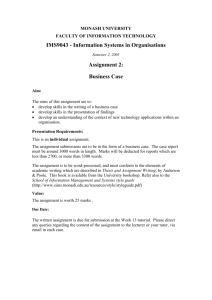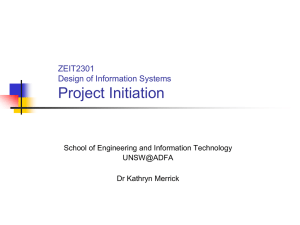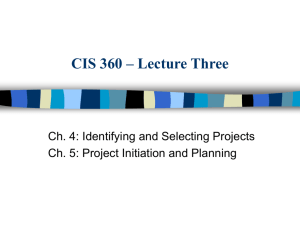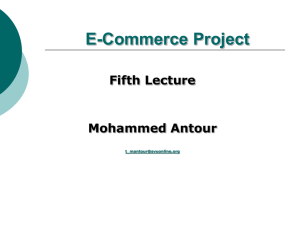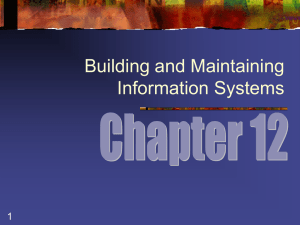Project management principles
advertisement
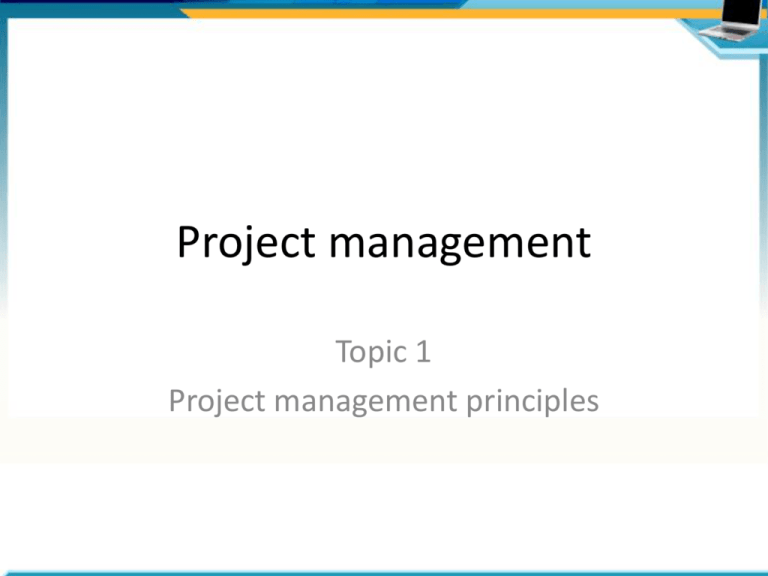
Project management Topic 1 Project management principles What is a project? • PRINCE®2 definition: a management environment that is created for the purpose of delivering one or more business products according to a specified business case • Another definition: a temporary organisation that is needed to produce a unique and predefined outcome or result at a prespecified time using predetermined resources Project characteristics • A finite and defined life span • Defined and measurable business products • A corresponding set of activities to achieve the business products • A defined amount of resources • An organisation structure, with defined responsibilities to manage the project Project life cycle • The tasks of specifying and designing a project through to testing and hand-over into operational use • It includes pre-project preparation Stakeholders Anyone with an interest in the project and its product including: – – – – Customers Users Suppliers Sub-Contractors who provide products or services to the supplier Whatever the team composition the customer should always participate Feasibility study • A feasibility study might be required to investigate a situation and determine options • A feasibility study can be conducted as a separate project and a second project can be undertaken to implement the outcomes of the feasibility study • A feasibility study typically consists of: – – – – Problem definition Investigation Development of options Submission of recommendations Process based • Eight distinct management processes – – – – – – – – Starting up a project Directing a project Initiating a project Managing stage boundaries Controlling a stage Managing product delivery Closing a project Planning Starting up a project Input: Project mandate that defines in high-level terms the reason for the project and what product is required Components: – – – – – – Design and appointment of project management team Project brief Project approach (how the solution will be provided) Customer’s quality expectations A risk log Initiation stage plan Directing a project Key process areas: • Initiation – Confirming the Business Case – Approving the Project Plan • Stage boundaries – Approving the start of the next stage – Resourcing the next stage • Ad hoc direction – Monitoring progress – Making decisions when the project goes off track • Project closure – Confirming that the project delivered the products – Releasing the resources Initiating a project • Objectives are to: – – – – – – Define how product quality will be achieved Plan and cost project Document and confirm the business case Enable the project board to take ownership Provide a baseline for decision making Agree to commitment of resources for the next stage • Key documents produced are: – – – – Project Initiation Document Quality Log Issue Log Lessons Learned Log Managing stage boundaries Objectives: • • • • Assure the project board that all products in the stage have been completed Provide information to assess the continuing viability of the project Approve current stage completion and authorise the start of the next stage Record measurements or lessons learned Documents produced: – – – – – – – – End Stage Report Current Stage Plan Next Stage Plan or Exception plan Revise Project Plan Updated Risk Log Revised Business case Lessons Learned Log Changes to structure or staffing or project management team Controlling a stage • Day to day management, monitoring and control activities • Cycle of: • • • • • • Authorising work to be done Gather progress information Watch for changes Review the situation Reporting Take corrective action • Products (documents) produced: – Work Packages – Highlights report – Update Issue Log – Update Risk Log – Update Stage Plan – Exception Report Managing product delivery Objectives: ensure that planned products are created and delivered – Team manager negotiates details of work packages with Project Manager – Ensures work is done – Assess work progress and forecasts – Ensure quality criteria met – Obtain approval for completed products Products (documents): • Team plans • Update Quality Log • Update Issues Log • Update Risk Log • Checkpoint reports (progress reports from Team Manager to the Project Manager) Closing a project • Objectives: execute a controlled close to the project – Check how well the objectives set out in the Project Initiation Document have been met – Confirm the customers acceptance of the product – Confirm maintenance and operation arrangements are in place, training – Recommendations for future work – Disband project organisation and release resources • Products (Documentation) – Lessons Learned Report – End Project Report – Archive project files – Post Project Review Plan – End Project Notification Planning • Planning is a repeatable process that plays a role in other processes such as: – – – – – – Planning an initiation stage Planning a project Planning a stage Updating a Project Plan Accepting a work package Producing an exception plan • Products (Documentation) – Plans – Product Checklist – Risk Log Components • • • • • • • • Business Case Organisation Plans Controls Management of risk Quality in a project environment Configuration management Change control Techniques • Product-based planning – What products are needed? – The sequence in which each product should be produced – Defining the form and content of each product • Change control – Assessing priority – Assessing impact • Quality review – Examining the product for errors – Taking corrective action




